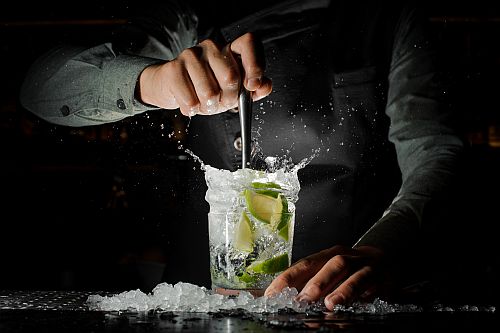What’s that sound? Oh, just the arrival of warmer, longer days filled with cocktails. Now that spring is officially upon us, it’s the perfect excuse to dust off those shakers and get to work whipping up some delicious drinks. And who better to help you on your way than a brand with almost 200 years’ experience? As a staple behind the bar, the House of Angostura’s aromatic bitters is a firm favourite in the industry, adding that extra depth of flavour to every cocktail it encounters. So, we got together with some friends to chat summer trends.
1. Low ABV tipples
The low- to no-alcohol wave has been gathering momentum, and with it, bars are getting creative with sophisticated mocktails and low ABV (alcohol by volume) drinks. In fact, last year, the Mindful Drinking Festival, celebrating an alcohol-free lifestyle, launched in Cape Town with over 1 300 people in attendance, and this year we welcomed Niks Bar, Joburg’s first alcohol-free watering hole. “I’ve come across many people who don’t necessarily drink at all but still want to go out and paint the town red,” says Taneale Van der Merwe, mixologist and World Class National finalist. For example, this is why the Rock Shandy – made with only soda, lemonade and Angostura aromatic bitters – has become even more popular of late in the bar scene.
Sabrina Traubner, head bartender at The Athletic Club & Social agrees, saying that she undoubtedly feels like it was heavily influenced by the recent ban. “People have become more aware of the negative effects of alcohol and will want to reduce these effects as much as possible by limiting the amount they drink on an evening out while possibly only going crazy once every so often.”
2. Locally inspired cocktails
Like the farm-to-table movement changed the way restaurants make food, so has it changed the cocktail scene. Bars are continuing to highlight the importance of fresh, local ingredients. And there isn’t a bigger proponent of this than Cause|Effect Cocktail Kitchen and Cape Brandy bar. Says owner, drink consultant, entrepreneur and top 100 influential bar figure, Kurt Schlechter, “We’re seeing an increase of drinks that are made with fresh, seasonal, savoury and herbal ingredients, straight from the farm to your bar counter.”
“We’re in such a uniquely diverse part of the world that we are actually spoilt for choice,” says Julian Short, co-owner of Sin + Tax. “I cannot wait to see how we as a continent further embrace our local ingredients, heritage, and special drinks culture into modern cocktail culture.”
Nkuli Khanyile, the joint winner of the Newcomer of the Year category at the 2019 BAR Awards, celebrated one of our most renowned local ingredients, the ever-versatile rooibos with her cocktail of gin, lemon juice, rooibos syrup, vanilla soda and Angostura aromatic bitters.
3. A return to the classics
Rather than mudding spirits with over-simplified, sugar forward mixers, we’re returning to a time where the spirit of the drink is celebrated. “We’re going back to a more classic way of mixing drinks which focuses on respecting the spirits while still having a drink that is delicate and light, but the spirit is still allowed to shine through and doesn’t have to compete with other flavours,” says Peter Lebese, the Angostura Global Cocktail Challenge 2020 SA National runner up. The Old Fashioned is the perfect embodiment of this with it’s simple yet elegant handling of the star spirit, bourbon, using sugar and Angostura aromatic bitters to enhance the tannins (and with Old Fashioned Week fast approaching you better get practising for the perfect serve!).
For Kurt, another cocktail he points to gaining traction in the industry is the humble sours. “Sours were starting to trend before lockdown. This will continue with foaming agents added, like egg white, aquafaba or foam drops.” For an unorthodox take of this classic, the Angostura Sour is bright and spicy, with a delightfully creamy texture.
“As most people won’t be spending as much time and money out and about anymore until they feel secure,’ adds Sabrina, “classic cocktails will become more popular, as well as popular signatures in bars that people specifically come back for.”
4. Health-focused ingredients
Consumer interest in healthy eating has infiltrated the drinks industry with the rising popularity of ingredients like Kombucha, Matcha, Moringa and chia seeds. “We’re seeing a lot of inclusion of ingredients such as ginger, turmeric and indigenous ingredients such as buchu and pelargoniums that have been proven to have health benefits,” explains Sabrina. With CBD-infused foods, water and skincare products continuing to be in demand, of course, cocktails aren’t immune either. Angostura aromatic bitters has long been lauded for its health benefits to curb sugar cravings, help maintain healthy blood sugar levels, encourage digestive enzymes, soothe gas and bloating, calm upset stomachs and nausea, and relieve occasional heartburn.
As a follow on to this, Peter has spotted the rise of bitter and umami flavours in cocktails. “People are moving away from sweet sugary drinks and mixologists have, in return, started using more vegetable ingredients in their cocktails like beetroot, yellow pepper and shitake mushrooms.” As the plant-based movement continues to advance, so will this trend in cocktails.
5. Ready to enjoy
Egged on by the lockdown, ready-to-drink cocktails have firmly laid claim to the at-home entertainment scene. People are embracing convenient, quality cocktail creations that they can enjoy anywhere. “Many companies in SA have already recognised this opportunity and ran with it such as Molecular Bars’ ‘Just Short’ range and Kegtails. Bars such as Lucky Shaker, Sin + Tax, and The Little Fox have sold pre-bottled cocktails for the consumer,” adds Taneale. The Little Fox says that their Batched n Bottled PB&H Old Fashion has proven popular with its nutty, peanut butter fast washed bourbon, honey and Angostura aromatic bitters winning over fans. “This way you can have your world-class cocktail and drink it in the comfort of your own home,” concludes Taneale.




